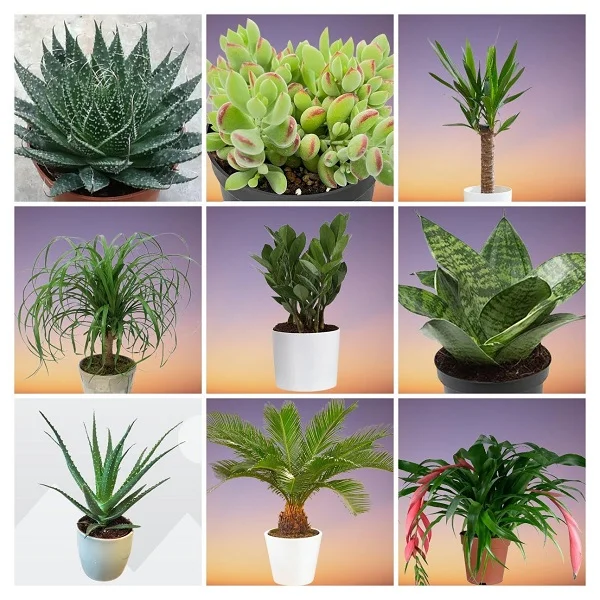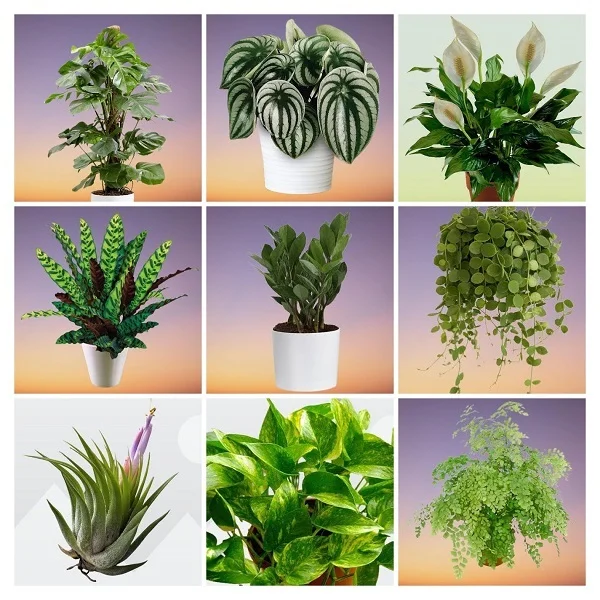Missionary Plant (Pilea peperomioides) Care and Propagation Guide
Some links in this post may be affiliate links
Pilea peperomioides (Missionary Plant) flourishes in bright light, moderate warmth, average humidity and moderately moist, fertile, succulents potting soil coupled with quarterly feeding in the growing season.
Pilea peperomioides also called Pancake Plant, Friendship Plant, Chinese Money Plant or UFO Plant is one of the popular succulent plants and bears round, dark-green leaves which are held on long petioles.
The stem in Chinese Money Plant is greenish to dark brown and often upright straight. The flowers are inconspicuous consisting of clusters of highly reduced unshowy, unisexual flowers.
The common name, 'Missionary Plant', is because a Norwegian missionary, Agnar Espegren, brought it from China to Norway in 1946, from there it was spread throughout Scandinavia.
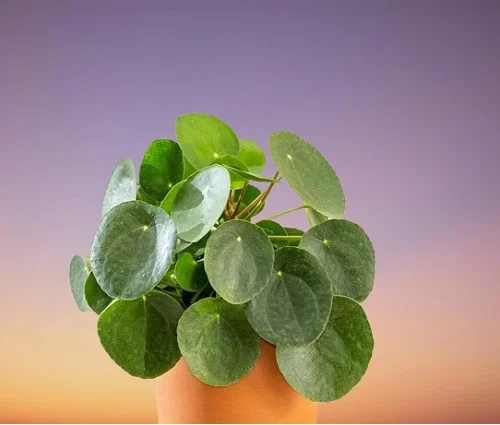
Botanical name: Pilea peperomioides
Family: Urticaceae
Common names: Missionary Plant, Pancake Plant, Friendship Plant, Chinese Money Plant, UFO Plant
Origin
Pilea peperomioides has its origins in Yunnan and Sichuan provinces in southern China.
Size
Missionary Plant is an erect, succulent, evergreen, perennial growing to a height of 12 inches only. The leaves are round, dark-green, about 4 inches in diameter and are held on long petioles. The compact size of this plant makes it one of the best low-light plants for small spaces like a study table to boost concentration or an office desk with no sunlight.
Toxicity
Pilea peperomioides is non-toxic to both humans and pets according to ASPCA. It is one of the pet-friendly plants that you may grow indoors.
Related Plants
The inflorescence in Chinese Money Plant is like that of Pilea cadierei (Aluminium Plant) while the leaves are like those of Peperomia polybotrya (Coin-leaf Peperomia) and hence the Botanical name Pilea peperomioides.
Where to Buy
Missionary Plants are a great addition to any plant collection, You may obtain them online frm Amazon (Link to Amazon).
Pilea peperomioides Care Indoors
Pilea peperomioides (Missionary Plant) blossoms in bright light, moderate warmth of 18-280C, humidity of 50-55% and moderately moist, fertile, succulents potting mix coupled with quarterly feeding during the growing season.
Missionary Plant requires regular pruning to keep it neat as well as encourage a bushy, compact growth. Repotting is needed when it becomes overcrowded to provide enough room for expansion. Keep reading for more on these growing conditions and how to provide them.
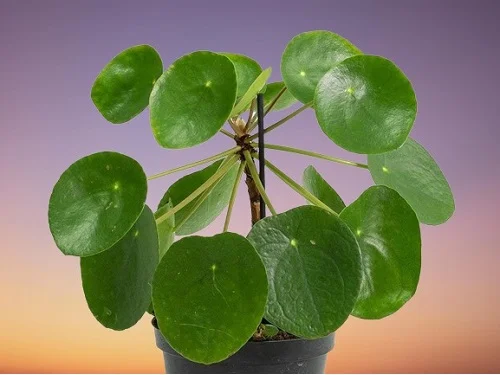
Light Requirements
Missionary Plant grows best in bright light. Keep it away from direct sunlight to avoid scorching of the leaves. Note that, the foliage will lose its bright green color if the light is too low.
Where the natural light is not adequate, consider growing Pancake Plant under grow lights. Take a look at these full spectrum grow lights on Amazon.
Rotate the pot regularly to ensure that the plant receives right on all sides for uniform growth and avoid leggy growth.
Watering
Water Missionary Plant liberally during the growing season while allowing the top half of the soil to dry out between waterings.
Cut down on watering during the cold season as growth is minimal at this time but do not allow the soil to dry out completely.
Ensure that the pot has a drainage hole and the soil is well-drained to prevent the soil from getting soggy as it can cause leaf drop due to root-rot.
Temperature and Humidity
Average warmth of 18-280C is ideal for Missionary Plant. Keep it away from cold drafts to avoid sudden drop in temperature which can cause reduced growth and leaf drop.
Average humidity of 50-55% is ideal for Missionary Plant. The plant has no need for extra humidity. However, if the leaf edges become crispy and curled, it is an indication that the air is too dry (low humidity). To up humidity, set the pot on a wet pebble tray or use a cool mist humidifier.
Regularly clean the leaves by damp-wiping with a soft cloth to get rid of dust and also discourage pest and diseases infestations. Maintain good air circulation to minimize fungal diseases.
Fertilizer
Feed your Missionary Plant with a balanced, liquid fertilizer every 3-4 months during the growing period for a lush growth. Do not feed in the cold season as growth is minimal and feeding at this time can lead to fertilizer burn.
Potting Soil
The best soil for Missionary Plant should be rich in organic matter, loose and free-draining to avoid getting soggy soil. The soil should be loose enough to allow water to drain out fast enough.
Pilea peperomioides is prone to root-rot if the soil gets soggy (retains too much water), therefore, cactus and succulents soil is ideal as it drains easily.
Repotting
Repot Missionary Plant when it becomes overcrowded in its current pot. Use a pot one size larger than the current one. Choose a clay pot as it allows soil to dry out faster and thus prevents the soil from getting soggy.
Make sure that the pot has a drainage hole to prevent the soil from getting soggy as it can lead to root-rot. If the plant is too overcrowded, divide it and pot the splits into individual pots to propagate new plants. Check out these succulents pots available on Amazon.
Pruning
The Missionary Plant does not require much pruning as it is slow growing. Pruning involves removal of yellow, dead and stray foliage to maintain the plant neat and reduce pest and disease infestations.
For a fuller and bushier plant, regularly snip off the topmost part of the stem and pinch off the plantlets as they appear so that the plant can focus its energy on sprouting new growth from the main stem.
Propagation
Pilea peperomioides (Missionary Plant) can be propagated in 3 ways; by plant division, from stem plantlets or from stem cuttings. Propagation is more successful when done at the beginning of the growing season.
How to propagate Missionary Plant by division
Missionary Plant produces offsets or pups at the base of the plant.
When the pups are about 1-2 inches tall, dig up the soil at the base to expose the roots.
Using a sharp sterile scissors, seperate the pup from the mother. Ensure each pup has enough roots.
Pot the pups in individual pots in moist, free draining soil which is rich in organic matter.
Maintain the soil moist until new growth has emerged inorder to begin normal routinue care for the new Missionary Plant.
How to propagate Missionary Plant from stem plantlets
Missionary Plant also produces plantlets on their stems which can be used to propagate new plants.
With a clean sharp knife, cut the plantlet at the point where it joins the mother plant to seperate it.
Pot the plantlet in moist, rooting soil and place the set up in a warm, well-lit place.
Maintain the soil moist through out until rooting occurs. Rooting is indicated by the emergence of new growth.
Wait until the Pilea peperomioides plantlet is well established before transplanting into a new pot after which you can begin normal routine care.
How to propagate Missionary Plant from stem cuttings
Missionary Plant can also be propagated from stem cuttings. The cuttings root easily and do not require a rooting hormone.
Take stem cuttings from the thicker, coarse brown stem of the Missionary Plant. The stem cuttings can either be rooted in soil or in water.
How to root Missionary Plant stem cuttings in soil
Insert the Missionary Plant stems cutting in moist rooting soil and place the set up in a warm, well-lit place.
Maintain the soil moist through out until rooting occurs. Rooting is indicated by the emergence of new growth.
Wait until the new Pilea peperomioides is well established before transplanting into a new pot after which normal routine care can begin.
How to root Missionary Plant stem cuttings in water
Place the Missionary Plant stem cutting in a container of water with at least 2 inches of stem on the lower cut end submerged in water.
Place the set up in a warm, well-lit place and change the water every 5-7 days. The stems cuttings may take about 4-6 weeks to develop roots.
Acclimatize the new Missionary Plant to growing in soil by gradually adding small amounts of soil into the water when the roots are about 2 inches long.
Transplant the new Pilea peperomioides when the roots have grown to about 4 inches long by which time all the water should be absorbed by the soil.
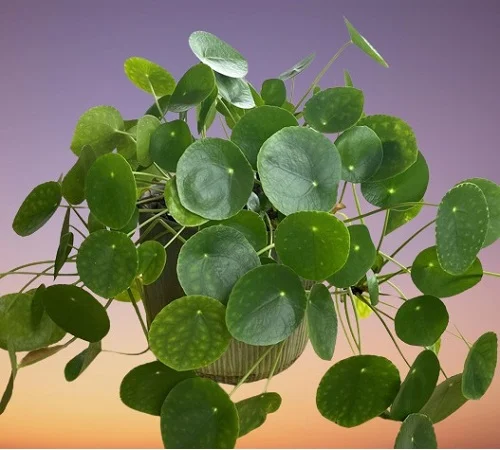
Pilea peperomioides Problems
Pilea peperomioides (Missionary Plant) problems include drooping leaves, dropping leaves, curled leaves, yellow leaves, wilting, leaf spots, pests and diseases among others. Keep reading for more on these problems and how to fix them.
Pests
Common pests in Pilea peperomioides are mealy bugs and spider mites. Isolate the affected plant to prevent spread to the rest of the plants and treat it with neem oil or insecticidal soap. Ensure to follow the manufacturer's recommendations.
Yellow leaves and mushy black stems
Yellow leaves and mushy black stems in Pilea peperomioides are an indication of either stem-rot disease or root-rot which are promoted by soggy soil. Use the unaffected foliage to propagate a new plant and discard the affected parts. To prevent the soil from getting soggy, ensure that the pot has a drainage hole and that the soil is free-draining.
Wilted, discolored leaves
Overwatering or soggy soil will cause wilted and discolored leaves in the Missionary Plant. Water the plant liberally during the growing season but allow the top half of the soil to dry out between waterings. Decrease watering during the cold season to keep the soil slightly moist. Ensure that the pot has a drainage hole to prevent the soil from being too wet. Read more on how to water houseplants the right way.
Discolored leaves, brown leaf tips and edges
There are three possible causes of discolored leaves with brown tips and edges in Missionary Plant. One possible cause is too much shade (too low light). Move the plant to a brighter spot where it will receive bright indirect light or instal grow lights where the natural light is not enough. Check out this guide on understanding light for houseplants.
The second possible cause of discolored leaves with brown tips and edges in Pilea peperomioides is a sudden drop in temperature. Keep the plant away from cold drafts from windy doors, drafty windows and air conditioning units to avoid sudden drops in temperature and maintain an average temperature of 18-280C. Check out this guide on understanding temperature for houseplants.
The third possible cause of discolored leaves with brown tips and edges in Missionary Plant is dry air (low humidity). Set the pot on a wet pebble tray or use a cool mist humidifier to elevate humidity. Learn more on how to raise humidity for houseplants.
Yellow or brown leaves with burnt-like edges
Potasium deficiency is the cause of yellow or brown leaves with burnt edges in Missionary Plant. Feed the plant with a high-potasium fertilizer. Ensure that the soil PH is between 6 and 7 which is the ideal PH for potasium uptake. Learn how to feed houseplants.
Lower leaves curled inwards
The cause of curled and softened lower leaves in Pilea peperomioides is a Nitrogen deficiency. Feed the plant with a high-nitrogen fertilizer and consider using a high-nitrogen fertilizer for the monthly feeding too.
Drooping lower leaves
Drooping lower leaves is a natural characteristic of Missionary Plant. The bottom leaves will droop as they grow older; this gives the plant its unique shape. The leaves do not need to be removed.
Curled, drooping leaves
Curled, drooping leaves in Missionary Plant are caused by underwatering. The plant thrives in moderately moist soil. Water the plant liberally during the growing season but allow half of the soil to dry out between waterings but do not allow the soil to dry out completely.
Dropping leaves
There are two possible reasons for dropping leaves in Missionary Plant. One possible reason is cold air due to cold drafts. Cutback the affected stem to induce new growth and move the plant to a warmer spot or protect it from cold drafts.
The second reason for dropping leaves in Pilea peperomioides is too wet soil. Avoid soggy soil by allowing the top half of the soil to dry out between waterings and ensure that the pot has a drainage hole.
You liked it? Share on social media.
Related Content
Amazon Associates Disclosure
Homeplantsguide.com is a participant in the Amazon Services LLC Associates Program, an affiliate advertising program designed to provide a means for sites to earn advertising fees by advertising and linking to amazon.com.



